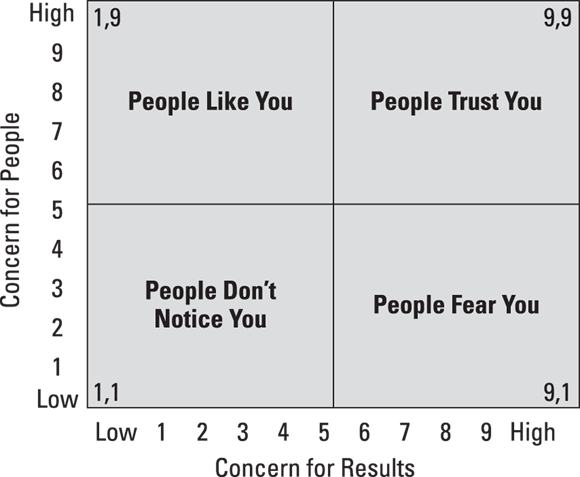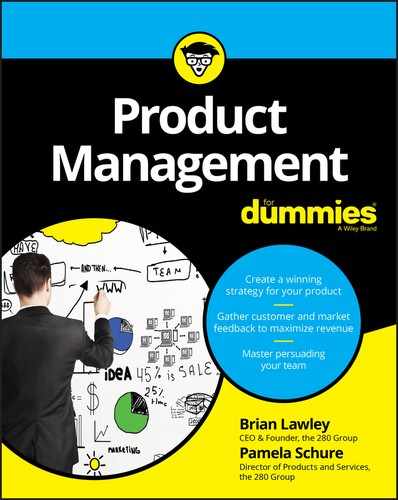Chapter 17
Cultivating Your Product Management Leadership Skills
IN THIS CHAPTER
![]() Breaking down what makes a great product management leader
Breaking down what makes a great product management leader
![]() Understanding how your strengths and weaknesses contribute to your leadership style
Understanding how your strengths and weaknesses contribute to your leadership style
Your role as a product manager may be a tactical role where you do lots of detail work with the team and make meaningful contributions to the team’s effort. Alternatively, you may step up to be a product leader, creating and driving the strategy while inspiring and guiding the team. For some product managers, the former is what they enjoy best and what leads to a rewarding career. But for other product managers, their passion is leading the team and the overall effort. Stepping up to do so takes a combination of courage, tact, and skill. Although cultivating leadership skills can enhance both career paths, this chapter is particularly targeted toward product managers aspiring to a leadership role with expanded responsibility. The chapter provides some insights into what it takes to develop into a leader.
Identifying Traits of an Effective Product Management Leader
A number of characteristics and abilities turn great product managers into great leaders. Following are the most important ones for you to develop in yourself:
- Vision: Vision is the propensity to see where the market, competition, and industry are going and to create a strong vision for where the product needs to be to win the market and satisfy customers. Enhancing vision includes both short-term and long-term thinking; it often requires defying what others in the company may believe because they don’t have as much information or customer and market insight as you do. With a strong and compelling vision, you can attract others to follow.
- Boldness: Boldness means to stand up for what you believe in. If you have great ideas but don’t make the effort to fight for them, you may never break out of your comfort zone and achieve a higher leadership role. Create opportunities for yourself by thinking outside the box and turning ideas into realities.
- Ability to influence: A product management leader must be able to use both logic and emotion to win over wide ranges of audiences as she is implementing the product vision and strategy she believes in. For example, if there is a particularly important feature that needs to be included with your product, can you find a way to use both data (to appeal to the logical side) and personal stories about customers (to appeal to the emotional side) to persuade your engineers to include the feature?
- Expertise: Being an expert in both the field of product management and the market segments your product targets is critical. If you aren’t an expert about the customers, markets, technology, and trends for your product, getting others to follow you will be difficult, if not impossible. For example, do you routinely spend time reading available articles about your market, competitors and customers online?
- Enthusiasm: Enthusiasm is contagious. An enthusiastic product manager brings people together. When you project enthusiasm, you get yourself and your team to aim for a higher level. You get others excited to be involved with your vision. Note: The opposite is even truer. A jaded and negative product manager will ultimately fail with both products and career advancement.
-
Tenacity: The ability to keep going despite facing difficult people and circumstances is critical. As a product manager, you encounter situations that seem insurmountable, and tenacity is the key to breaking through. The effort isn’t a one-time activity or meeting. It’s succeeding in the long-haul with a vision and campaigning to achieve your goal.
 Hiring managers instinctively look for tenacity in product managers. When faced with an obstacle, did the PM give up or work through it? One great approach if you have what appears to be an insurmountable challenge is to break it down into smaller steps and affect as much change as you can.
Hiring managers instinctively look for tenacity in product managers. When faced with an obstacle, did the PM give up or work through it? One great approach if you have what appears to be an insurmountable challenge is to break it down into smaller steps and affect as much change as you can. - Commitment to excellence: This characteristic includes excellence in both the work you do and deliverables. Your presentations, market requirements documents, and business cases should read well and look amazing. Your product details should shine. The product manager is at the center of all aspects of the product. If you don’t own delivering excellence for all aspects of the product, no one else will.
Developing Your Leadership Style
Leadership style is a very personal thing. It is highly dependent on your own personality and what you are good at. Anyone can be a great leader: introvert or extrovert, highly analytical and detail oriented or big-picture thinker. The key is to be authentic about who you really are rather than trying to be someone you aren’t. This section covers two different leadership styles as well as handling stress and communicating like a leader.
Reaching for results and motivating people
There are two primary factors to consider when determining your leadership style: concern for results and concern for people. Leaders often tend to be stronger and more focused on one than the other. The result is that their leadership effectiveness varies quite a bit. Look at Figure 17-1 to understand how people perceive leaders depending where their leadership focus is.
- Fear: If you’re more concerned with results than you are people, you may get short-term results; however, in the longer term, your team members may leave, choose to not cooperate, or even turn against you. A results-only focus leads people to fear you. This path can cause them to behave passive-aggressively and build up resentment and may contribute to nasty corporate politics that hamper your product success or even limit your career.
- Like: On the other hand, if you’re only concerned with making people happy, you may have a team that likes you as a person but doesn’t do what’s required to achieve the business results that the company demands. As the product manager, you’re still accountable for the overall results, so if product success doesn’t happen, you get the blame from the executive team.
- Not noticed: If you don’t focus on results or people, from a leadership perspective, you become irrelevant. People don’t notice what you say and don’t take your opinion into account. By all means, avoid being a product manager who people don’t notice.
- Trust: A true product management leader finds a way to walk the fine line and focus on both results and people. The outcome is that the team and stakeholders trust the product manager. Trust means that they are willing to support his vision and work hard to achieve it. In some instances the trust and respect that you earn mean that you sacrifice popularity. Your stakeholders’ trust in you comes from their understanding of the balance you strike between results and making people happy. Look back through your career, and you’ll most likely uncover leaders who cared about both results and people and achieved highly successful outcomes. These leaders may not have been liked, but they were trusted to take teams on challenging journeys. Make sure you become one of these leaders.

© Colleen O’Rourke, rTen Consulting
FIGURE 17-1: Leadership grid.
Handling stress
Product management is a stressful job. You have conflicting demands. The path forward to success isn’t always clear, and you often have to go back to your stakeholders and ask them to make changes. Change can induce stress in them and you. This section covers how to deal with stress within yourself and with others.
Turning a negative into a positive
Because doing your job often means making stakeholders’ jobs more stressful, over time, your arrival in someone’s office or even your name on an email can induce a stress response. To counteract that, you must become the most positive and complimentary person in the office. A 5:1 ratio rule can help you overcome the stress deficit that you create in others. The basic rule is that five positive interactions can offset one negative interaction. Both this chapter and Chapter 18 frequently reference taking people to lunch; that act counts as one positive interaction. Here are just a few other ways to get to five:
- Congratulating and thanking someone for a job well done
- Telling a joke
- Showing interest in employees’ children and hobbies
- Smiling at team members in the hallway
What other ways can you think of?
Managing stressed-out stakeholders
Humans are hard-wired to react to danger, stress, or conflict (real or imagined) with one of three instincts: fight, flight, or freeze (see Figure 17-2).

© Colleen O’Rourke, rTen Consulting
FIGURE 17-2: The three modes of reacting to challenges.
Because you can’t stop the stress process from happening, your goal is simply to acknowledge that it’s going to happen and work through each stage until your harried stakeholder gets back to a calm state where you can both deal with the new challenge in front of you.
Following are of the top ways for calming down stakeholders:
- Tell the people involved that you understand their disappointment. Just accurately naming their emotion at this point takes the sting out of the emotion.
- Give them time to work through their anger (fight), withdrawal (freeze), or non-acceptance (flight) of the new information. For big changes (or team members especially sensitive to change), offer to come back to discuss the change further when they’ve had time to digest the information. If the calming process just takes a minute or two, hang tight. Practice your active listening skills and keep using them as you collectively develop a path forward. Active listening skills are covered in Chapter 18.
Reducing your own stress
You aren’t immune to stress reactions. Plan for them. If you feel your blood boiling, are stunned into silence, or find yourself walking away, tell people that you’re trying to digest the change and ask them to give you a few moments to compose yourself. Work out exactly the steps that work for you, and then put your plan in place. Over time, your co-workers learn that you have a certain way of dealing with stress and respect that you can manage your way through the situation.
Building confidence
The key to building confidence is to recognize that your emotional reactions are part of your human nature. Building confidence is discovering how to work with your natural tendencies to turn each of these situations into an opportunity to exercise your courage muscles. Instead of giving in to your first instinct of fight, freeze, or flight, work on a deliberate and conscious approach to facing difficult situations. Your solution to facing difficult situations combines both sincere and genuine concern for the people involved and the results you’re trying to achieve. When you do both, you’ll be practicing true leadership. The results you can achieve over time may astound you.
Thinking, acting, and communicating like a leader
The old axiom that people perceive you based on how you perceive yourself is highly applicable in product management leadership. If you think of and view yourself as a leader, you’re more likely to project the qualities of a leader. Similarly, others sense when you don’t think of yourself as being capable of leading.
As a product manager, you need to practice thinking, acting, and communicating like a leader at all times.
- Act decisively. Don’t waffle when you communicate or take action. Make decisions and lead others by using your business analysis skills, market and customer expertise, and don’t be afraid to make mistakes.
- Ask for help. Don’t be afraid to ask for help if you aren’t sure or need more information. The best leaders know that they don’t have all the answers and that the teams they’re leading often do. In fact, people are flattered when you ask for their advice.
-
Give credit, take blame. Leaders are the ones that give themselves permission to give others credit for what has gone well. They also take the blame when things didn’t work out as planned. Leadership doesn’t come with a red hero cape. It comes with a huge dose of humility.
 If you think giving others credit makes them the leader, try this exercise: Next time something good happens in the group, be the first person to give someone else credit. Since leaders are the ones that are supposed to give credit to others, over time, you become perceived as the leader.
If you think giving others credit makes them the leader, try this exercise: Next time something good happens in the group, be the first person to give someone else credit. Since leaders are the ones that are supposed to give credit to others, over time, you become perceived as the leader.
